In 2026, handmade ceramic pottery is becoming one of the most sought-after trends in home styling. Consumers are turning to hand-thrown pieces for their authenticity, sophistication, and emotional connection to the maker. Whether used for cooking, decorating, or collecting, pottery made by hand brings a unique soul to modern spaces. In this article, we explore 10+ handmade ceramic pottery pieces to elevate your home décor in 2026.

1. What is handmade ceramic pottery?
Handmade ceramic pottery refers to any type of pottery that is crafted by hand rather than produced by machines. At its core, it starts with clay, water, and the maker’s hands. Every curve, indentation, or form is a result of human action and intention.

2. Why choose handmade ceramic pottery
2.1. Uniqueness and aesthetics
Unlike mass-produced ceramics, handmade ceramic pottery carries natural variations. These may include slight irregularities in shape, unique glaze drips, or textured surfaces. These tiny imperfections make each piece one-of-a-kind. No two pieces are identical, even if the potter tries to replicate the same design.
2.2. Functionality and durability
Many people mistake handmade for fragile, but high-quality pottery can be incredibly durable. Stoneware and porcelain pieces are often fired at high temperatures, making them strong enough for everyday use. As long as they’re made correctly, handmade ceramic pieces can be dishwasher-safe and microwave-safe. Some potters also design pieces for oven use, so long as they are thermally stable and properly glazed.
2.3. Sustainability and slow living
In an age of fast consumption and mass production, owning handmade ceramic pottery supports local artisans and promotes conscious buying. Instead of purchasing disposable products, you invest in items meant to last for years. Opting for handmade ceramic pottery aligns with the slow living lifestyle – choosing fewer but better quality items.
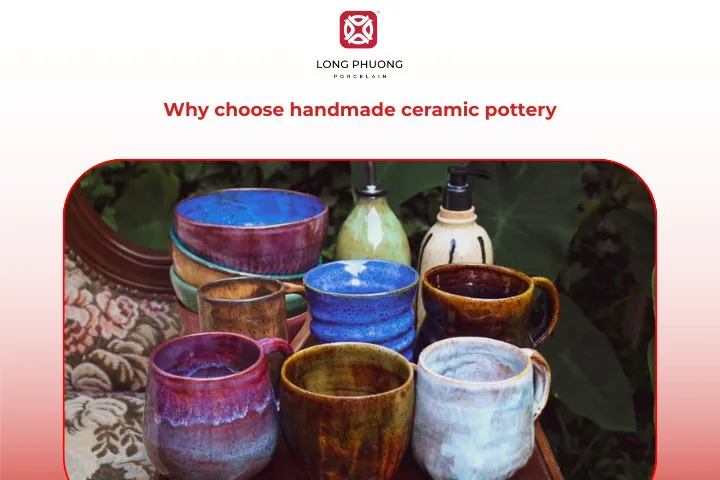
3. 4 styles of making handmade ceramic pottery
3.1. Handbuilding
Handbuilding is the most basic pottery method, created entirely by hand without a wheel. Artists shape clay using techniques like pinching, coiling, or slab building. This approach allows for unique textures and organic forms that reflect the maker’s personal touch. It is especially popular for sculptural or decorative pieces. Functional items like bowls and mugs can also be made using this method.
3.2. Slip casting
Slip casting involves pouring liquid clay, called slip, into plaster molds to form shapes. This technique is ideal for producing multiple identical pieces efficiently. It also allows for creative effects like color blending or marbling. Artists usually make a master model first and then replicate it through molds. Many modern ceramic brands use slip casting to scale up their designs.
3.3. Wheel throwing
Wheel throwing uses a potter’s wheel to create symmetrical pottery. The clay is centered on the spinning wheel and shaped by hand into bowls, mugs, vases, or other cylindrical forms. It requires precision, control, and practice to achieve even walls and balanced shapes. Wheel throwing is widely used for functional pottery, but can also include decorative elements added later.
3.4. Sculpture
Sculptural pottery focuses on artistic expression rather than function. Artists shape clay by hand to create freeform, figurative, or abstract designs. This style allows experimentation with textures, shapes, and mixed materials. Sculptures often take longer to complete and are mainly used for display rather than everyday use.
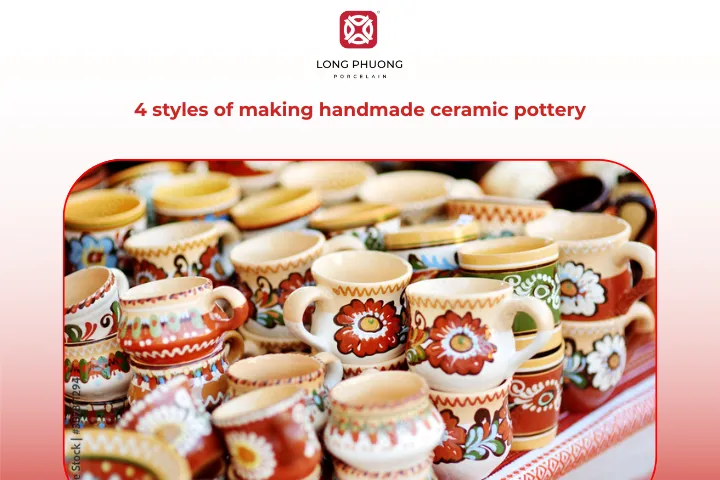
4. The handmade ceramic pottery making process
Each handmade ceramic piece goes through multiple stages to complete. Here are 10 essential steps involved:
- Step 1 – Design: Every piece begins with an idea. Potters brainstorm and sketch designs, drawing inspiration from various sources before deciding on the shape, size, and style of the pottery.
- Step 2 – Build: Clay is prepared and shaped into the desired form using techniques such as handbuilding, slab construction, or wheel throwing. This step defines the overall structure and functionality of the piece.
- Step 3 – Finish: Once the basic shape is complete, the clay is left to reach the “leather-hard” stage, firm enough to refine shapes, trim bases, and prepare the piece for drying.
- Step 4 – Sanding: After the clay has dried into greenware, sharp edges are smoothed, and surfaces are polished to prevent imperfections before the first firing.
- Step 5 – First firing: The dried pieces are carefully loaded into a kiln for the bisque firing, which permanently hardens the clay and prepares it to accept glaze.
- Step 6 – Glazing: A glaze is applied to the bisque pieces using brushing, dipping, or pouring techniques. The glaze adds color, texture, and a protective surface.
- Step 7 – Second firing: The glazed pottery is fired again in the kiln, fusing the glaze to the clay and creating a smooth, non-porous finish.
- Step 8 – Detailing: Additional decorative touches, such as gold or colored overglaze, are carefully brushed onto the pottery before the final firing.
- Step 9 – Final firing: The pieces undergo a final, quick firing to set the decorative details and ensure durability without damaging the glaze.
- Step 10 – Final touches: Pottery is inspected, bottoms are smoothed, and pieces are prepared for storage or shipment. Every item is now complete, ready to be enjoyed in homes.
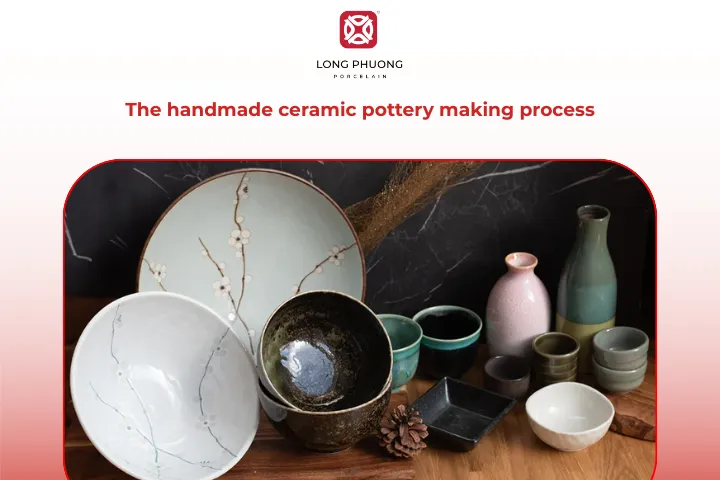
See more: Discover 2026’s hottest trends in ceramic home decor
5. Popular handmade ceramic pottery techniques
5.1. Fire glaze technique
Fire glaze involves carefully controlling high-temperature firings to create flowing, flame-like patterns on the pottery surface. Using iron oxide, titanium, and other materials, artisans achieve unique colors and textures. Each piece becomes a one-of-a-kind work of art, combining precision with artistic flair.
5.2. Hand-drawn technique
Hand-drawn or hand-painted ceramics allow artisans to decorate pieces with intricate patterns and motifs. Every item is unique, reflecting the personal touch and vision of the artist. This technique preserves traditional beauty while giving ceramics a story and cultural connection.
5.3. Glazing technique
Glazing applies a thin, glassy layer over the fired ceramic to create a smooth, glossy, and durable finish. It enhances both aesthetics and longevity, while providing a canvas for patterns and colors through brushing, dipping, or spraying. Glazing also protects ceramics from stains and wear.
5.4. Carving and engraving technique
Carving or engraving adds depth and texture, with designs created using precise tools. Lines, hollows, and patterns convey stories or cultural motifs. This technique requires both skill and patience, and it has been an important tradition in Vietnamese and global ceramics for centuries.
5.5. Enamel technique
The enameling technique applies colorful enamel layers over a metal or ceramic base. This method produces vibrant, durable surfaces with rich decorative motifs. Enamel ceramics combine artistic beauty with lasting craftsmanship, preserving cultural heritage.
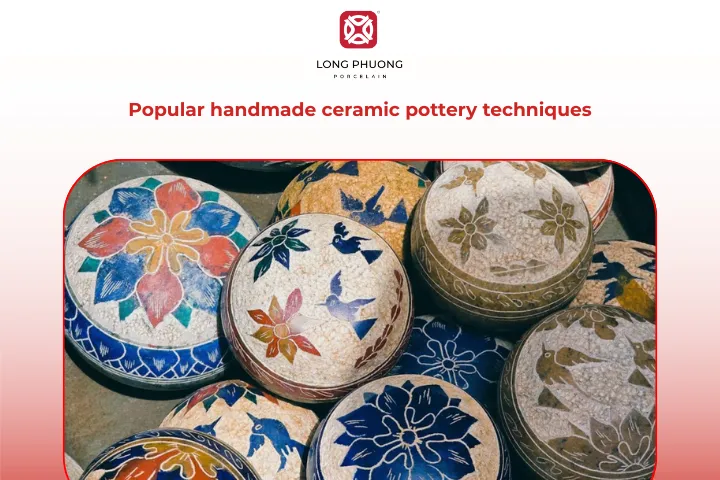
6. 10+ best handmade ceramic pottery for a 2025 home
6.1. Handmade ceramic incense stick holder
Clean and understated, yet it makes a statement. Place it on a console, nightstand, or altar to add a natural touch. It also fills the room with a pleasant scent when in use.

6.2. Handmade ceramic mugs
Go for matte textures, soft tones, and organic shapes. A set of handmade mugs works as practical drinkware and adds a cozy, stylish vibe when displayed on open shelves.

6.3. Handmade ceramic plates and bowls
Perfect for creating a calm, intentional dining experience. Whether stacked on a shelf or set for a meal, they bring warmth and a grounded feel to your table.

6.4. Handmade ceramic mini sculpture
Decorative ceramic sculptures add personality and texture to shelves, mantels, or side tables. Choose pieces that reflect your style for a curated look.

6.5. Handmade ceramic electric diffusers
These handcrafted diffusers combine beauty and function. They release gentle fragrances while serving as eye-catching decor, especially when paired with natural, earthy elements.
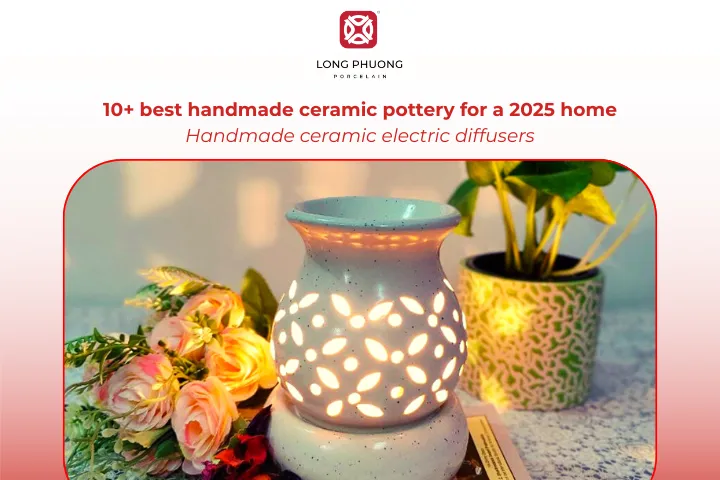
6.6. Handmade ceramic vases
Handmade ceramic vases with soft curves or unique textures instantly elevate a room. They work beautifully with fresh flowers, dried blooms, or even on their own as sculptural pieces.
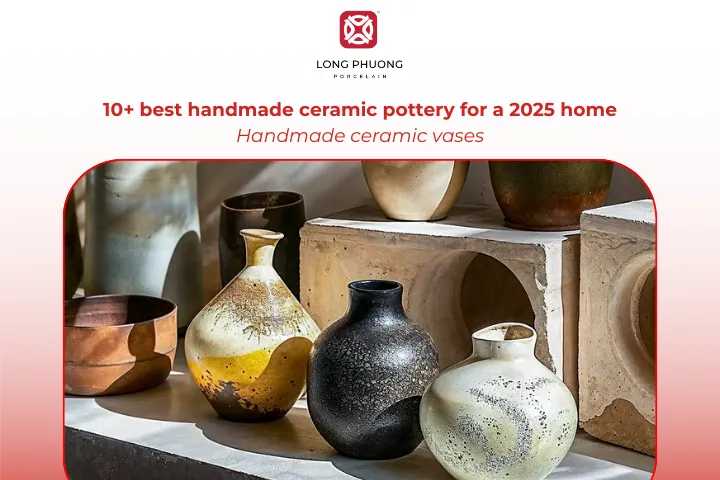
6.7. Handmade ceramic carafes
Perfect for serving water, juice, or wine, handmade pitchers add charm to your table. Their unique shapes and finishes make them a visual highlight even when not in use.
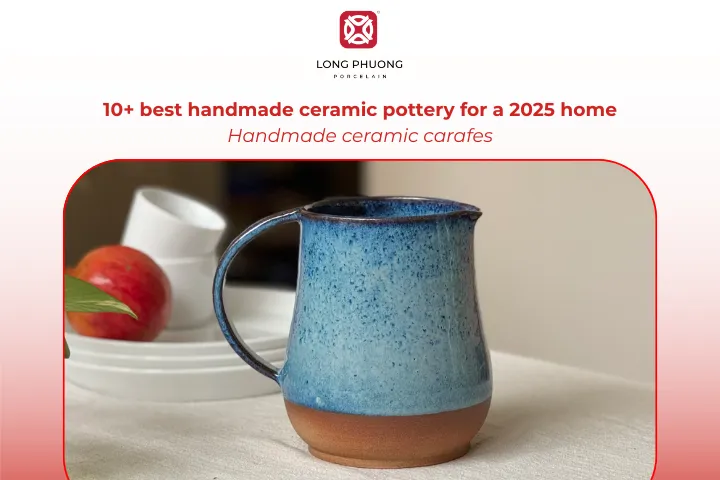
6.8. Handmade ceramic planters
Add a touch of greenery with handmade ceramic planters. Their natural textures and soft colors make plants feel like part of a curated, mindful space.

6.9. Handmade ceramic tea sets
A handcrafted tea set brings ritual and charm to everyday life. Look for pieces with soft glazes and simple lines that enhance both function and aesthetic.
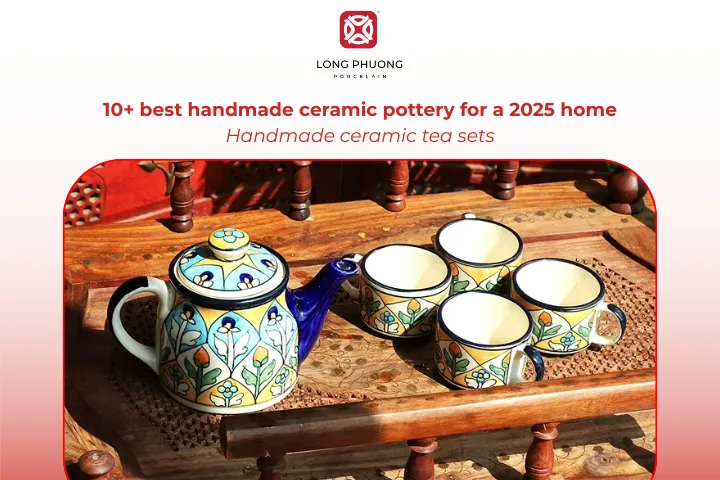
6.10. Handmade ceramic wall pieces
Use handmade ceramic wall accents to add texture and interest to your walls. These pieces serve as subtle art, blending craftsmanship with natural beauty.

7. Using handmade ceramic pottery in daily life
7.1. Using handmade ceramic pottery for serving and cooking
Ceramic pottery is extremely versatile. You can use shallow bowls for pasta or salads, lidded pots for slow-cooked stews, and flat plates for cheese or dessert presentations. Many high-fired ceramics are oven-safe, making them perfect for baking dishes like gratins or casseroles. You can also repurpose ceramic trays for displaying fruit, dried flowers, or even candles on coffee tables or kitchen islands.
7.2. Using handmade ceramic pottery for styling your home
Stick to a palette of neutral or earthy tones to create cohesion among different ceramic pieces. Combine matte and glossy finishes for visual interest, and mix shapes and heights when arranging pottery on tables or shelves. For casual meals, pair pottery with wooden cutlery and fresh greenery to create a natural, welcoming setting. For special occasions, add metallic accents to elevate the look while maintaining understated elegance.
7.3. Using handmade ceramic pottery for gifting and heirloom potential
Handmade ceramics make thoughtful and lasting gifts. Their durability and timeless beauty allow them to be treasured and passed down through generations. Whether it’s a mug, a vase, or a platter, pottery reflects care and individuality. For milestone events like weddings, housewarmings, or anniversaries, customized ceramic pieces become meaningful keepsakes that grow in sentimental value over time.
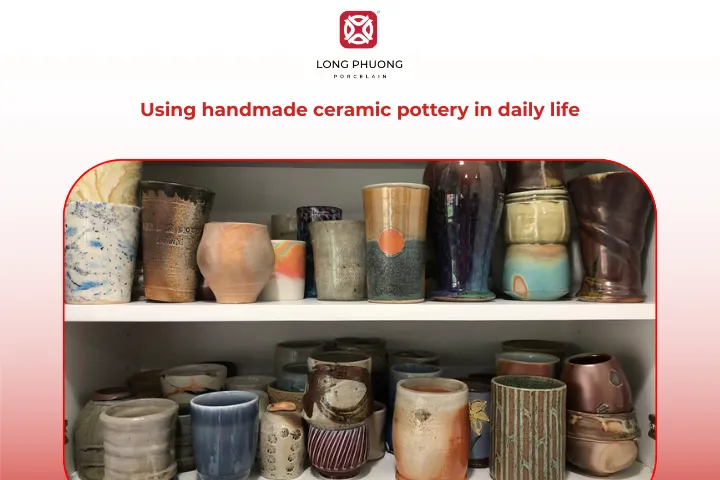
8. Long Phuong Porcelain – A leading distributor of fine porcelain products
Long Phuong Porcelain is a top distributor of high-quality porcelain products in Vietnam. We specialize in combining traditional craftsmanship with modern design, offering a wide range of porcelain items for both everyday use and decorative purposes. Our collection includes tableware, tea sets, vases, mugs, and cups that showcase Vietnamese artistry and meticulous attention to detail. With a strong focus on quality and customer satisfaction, Long Phuong Porcelain has earned a reputation as a trusted source for beautifully crafted porcelain.

9. FAQs
9.1. Are handmade ceramics microwave safe?
Many handmade ceramic pieces, especially those made from high‑fire stoneware or porcelain and coated with a proper glaze, can be microwave safe. However, if a piece has metallic decorations or special “luster” glazes, it should not go in the microwave. If you are unsure, a simple test can help: fill the piece with water and heat it for a short time; if the water gets hot but the ceramic stays relatively cool, it’s likely safe.
9.2. How long does handmade pottery last?
With proper care, handmade ceramic pottery can last for decades or even generations. Many potters and studios report that their pieces become lifelong household items or heirlooms. Of course, like any ceramic item, it can break if dropped or exposed to extreme/rapid temperature changes.
9.3. Can handmade ceramics and pottery be used for cooking?
9.4. Why are handmade ceramics so expensive?
Handmade ceramic pottery involves many steps that require time, skill, and resources. Beyond materials, you’re paying for the artisan’s labor, expertise, and often for the kilns’ energy and studio overheads. Also consider the costs of failed pieces that don’t make it to sale. Those overheads get distributed across successful pieces, increasing their price.
9.5. Can you make ceramic pottery at home?
Yes, many people start by using home pottery kits or local pottery studios. As long as you have access to basic tools and follow the proper steps, you can create functional ceramics. However, homemade pottery demands patience and care: drying slowly, applying glaze correctly, and ensuring safe firing and finishing are crucial to avoid cracks or food‑safety issues.
9.6. How much should a handmade mug cost?
Prices vary widely depending on craftsmanship, materials, glaze, size, and complexity. A handmade mug typically sells for $25 to $300, depending on the artist’s reputation and the amount of labour involved. Many functional, well‑made mugs fall into a more common range of $35 to $75, reflecting the cost of materials, kiln firing, glazing, and the many hours of labor behind each piece.
10. Conclusion
Handmade ceramic pottery stands out from mass-produced items. Each item reflects skill, creativity, and care, making it perfect for daily use, décor, or gifting. Choosing handmade ceramics and pottery supports artisans and brings a personal, timeless touch to any home.
Related articles
CEO of Long Phuong Group Joint Stock Company, with more than 20 years of exploration and research to obtain the best formulas and professional experience, Long Phuong Porcelain has produced more than 400 designs of all kinds of household porcelain, Significant contributions to Vietnam's ceramic industry.
 Vietnam
Vietnam
